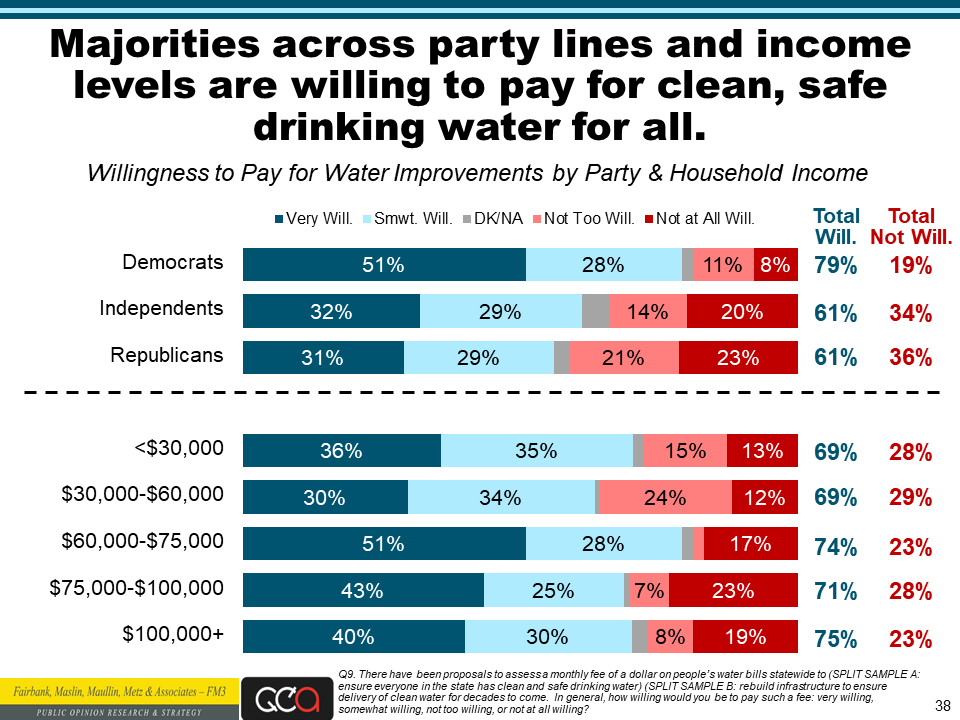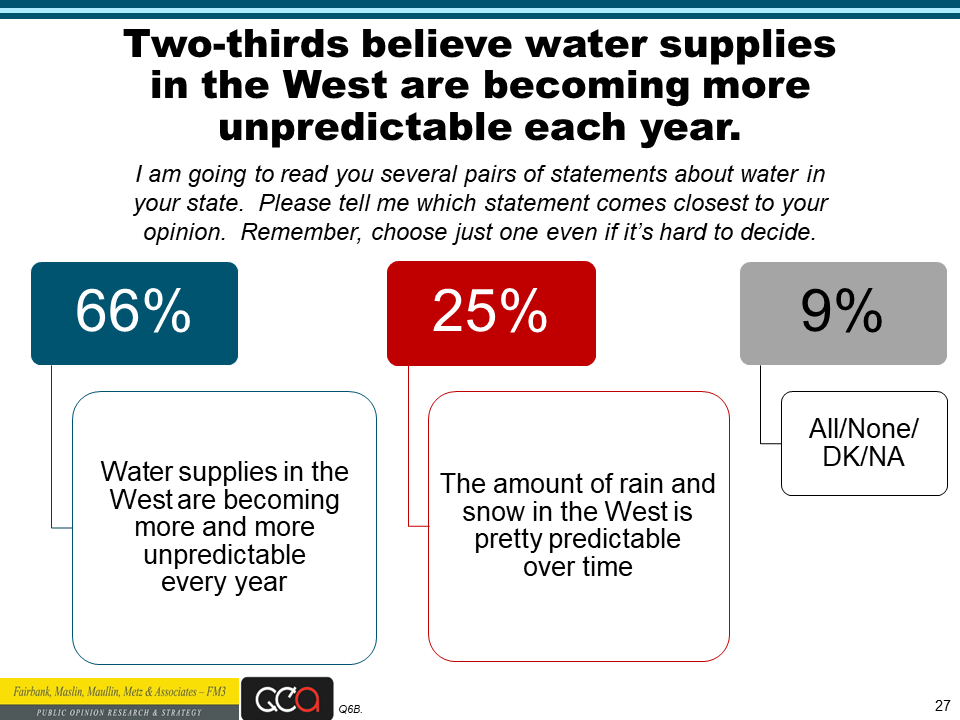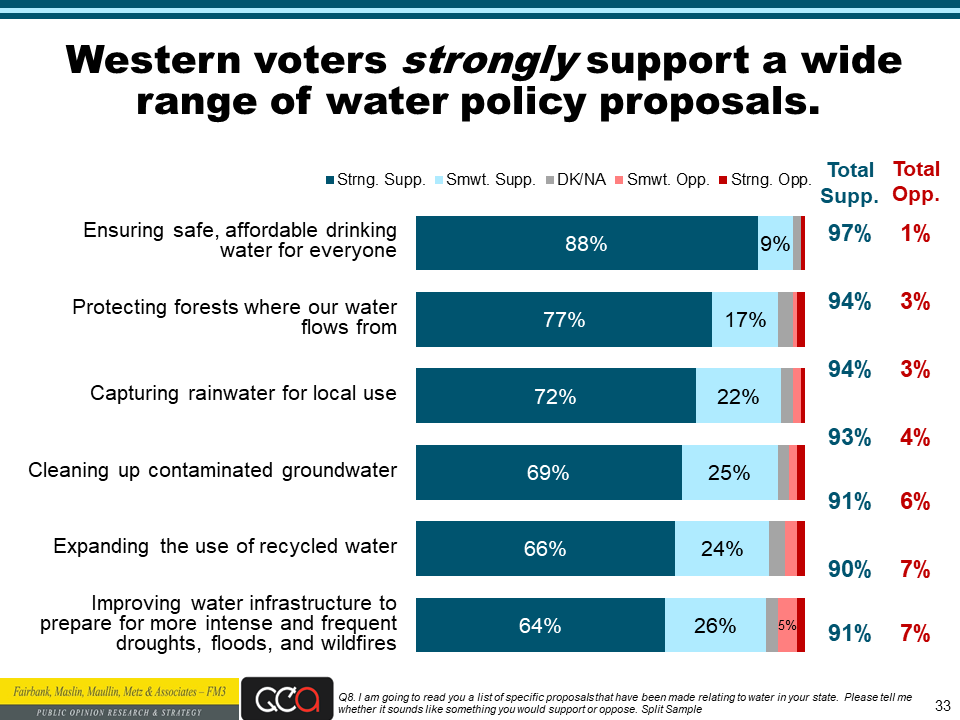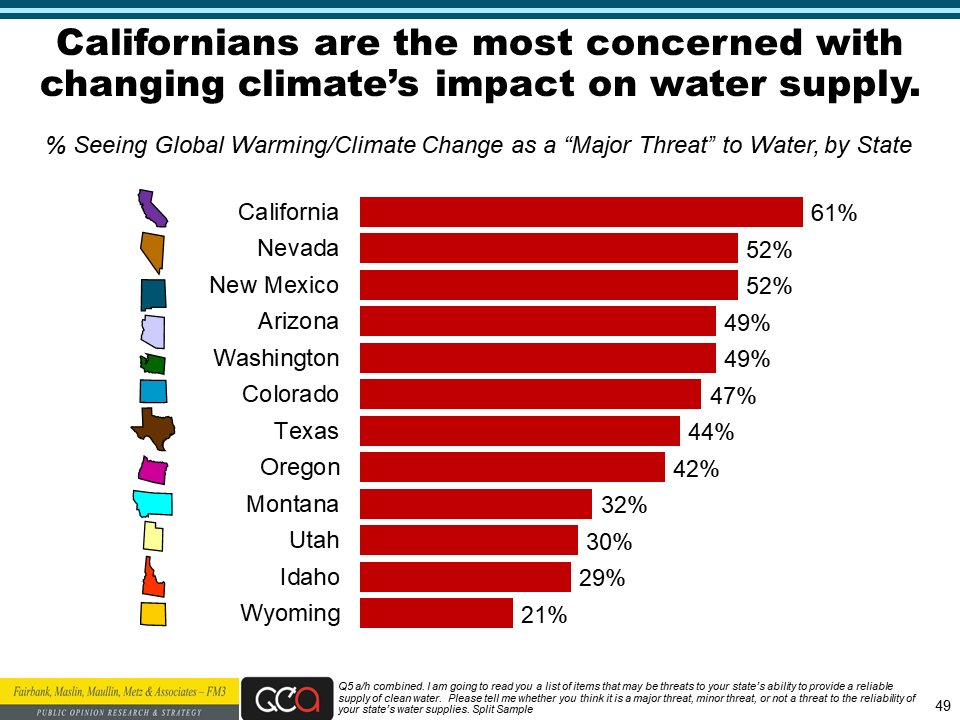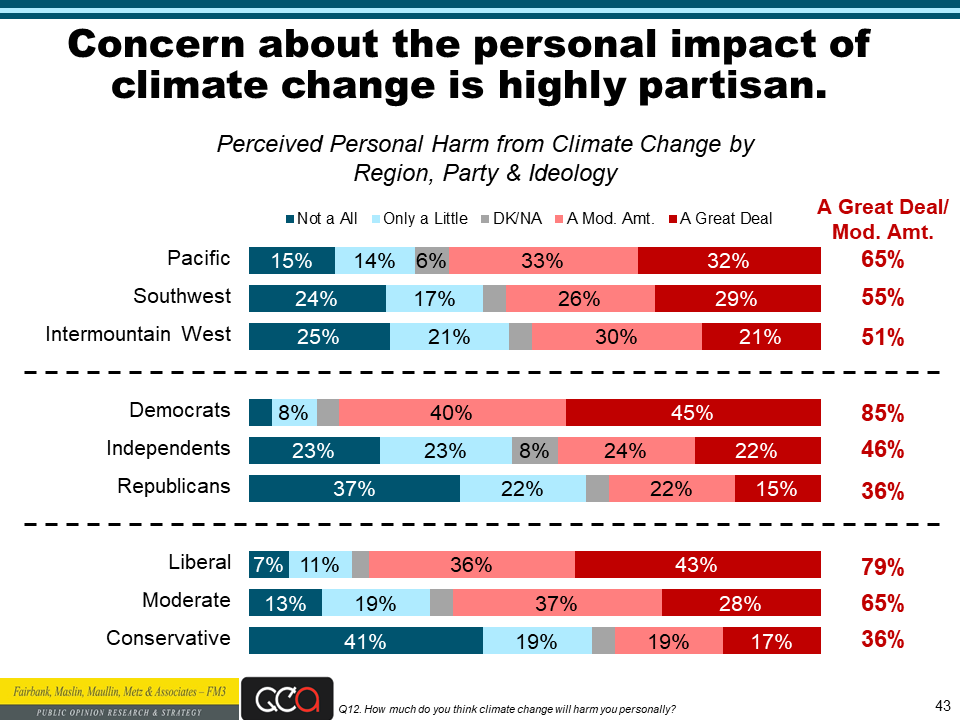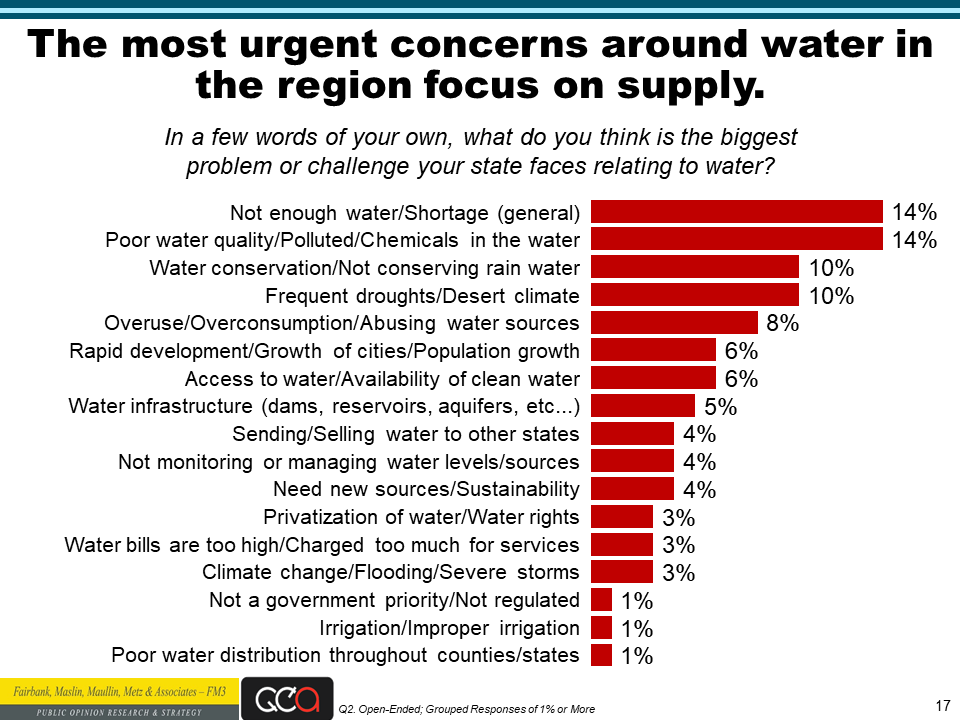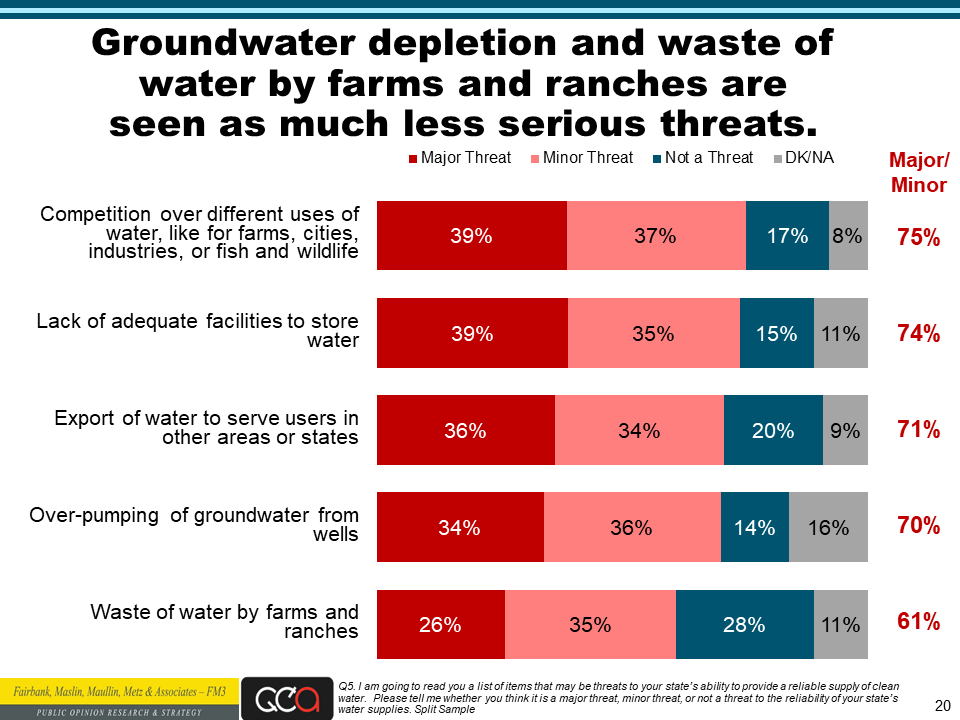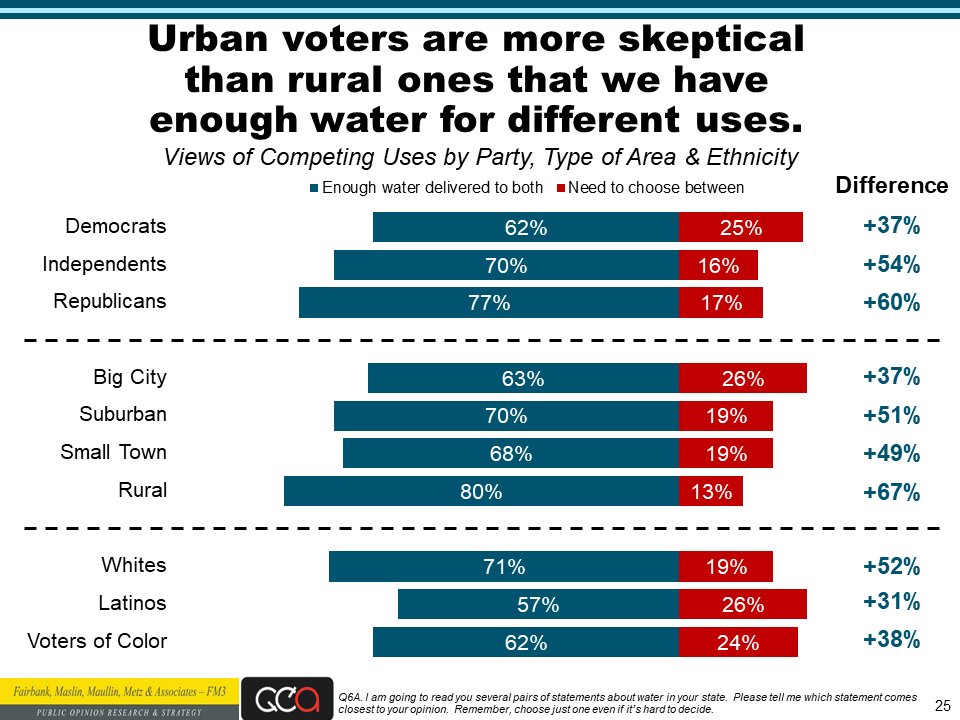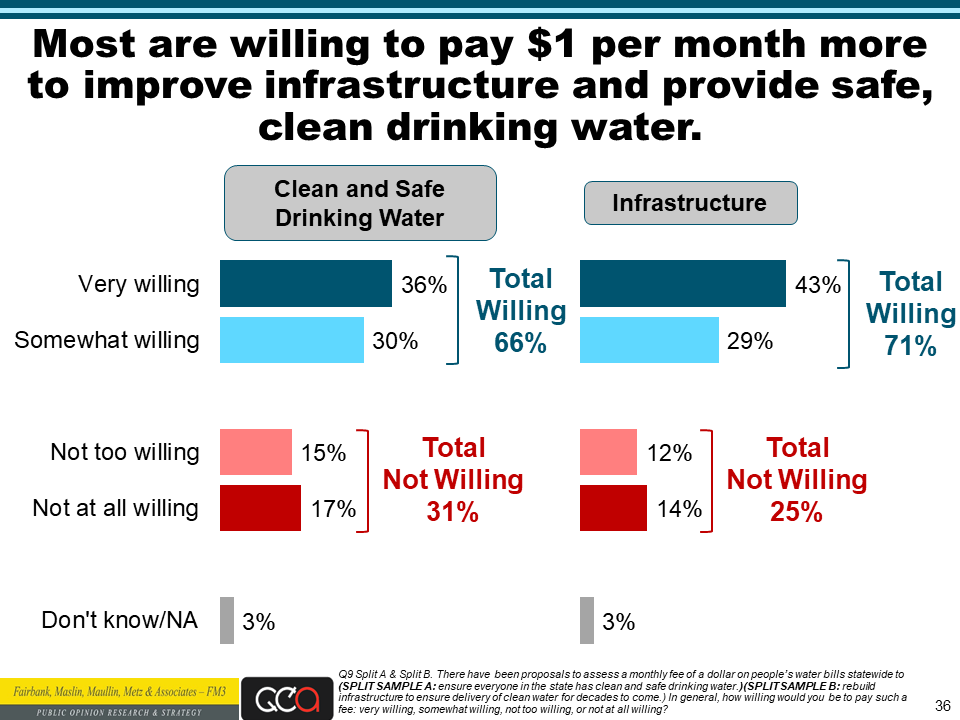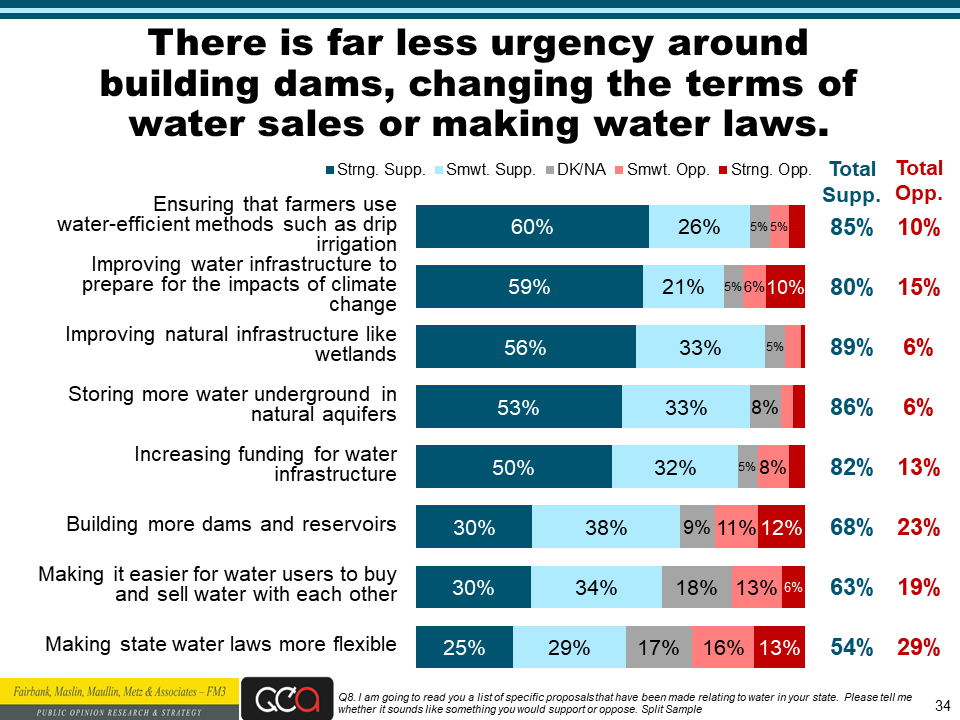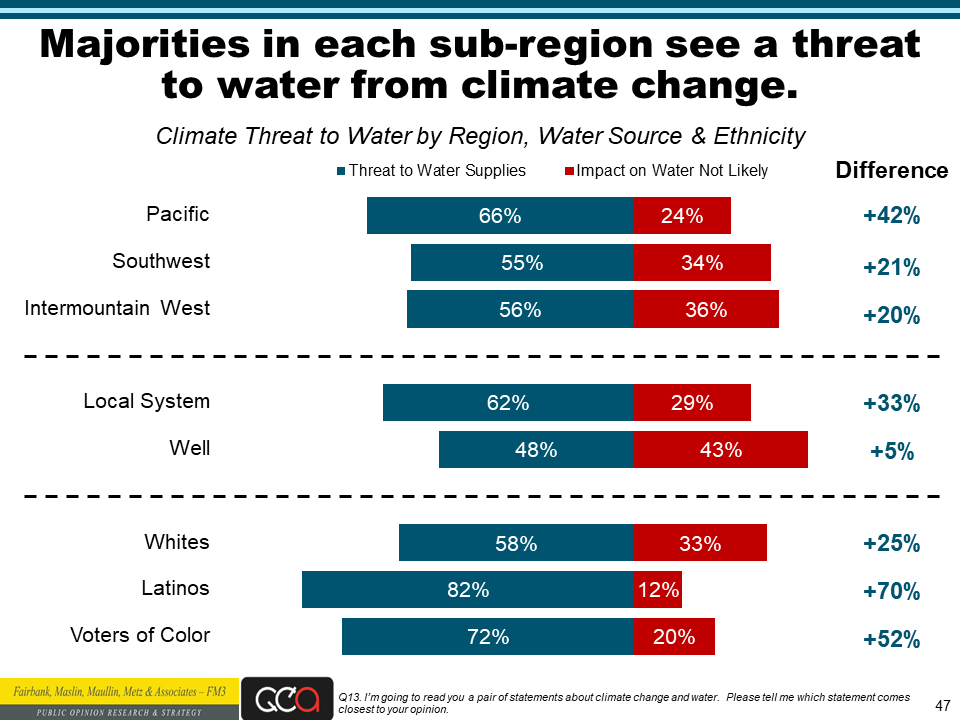Q&A with Wade Crowfoot, CEO of the Water Foundation
What do Westerners think about water issues? What worries them? What policies do they support? Where is there consensus and division?
To answer these questions, the Water Foundation recently commissioned a wide-ranging public opinion survey of voters in 12 Western states. The poll covered diverse topics, including general awareness of water issues, opinions on policy measures, perceptions about the value of water, and beliefs about both weather and climate change.
I covered some of the highlights of the poll in this previous post outlining a dozen key findings that pollsters Dave Metz and Lori Weigel present in their PowerPoint (see a gallery of the pollster’s slides on this page).
To learn more about the poll’s motivation, findings, and implications, I recently interviewed Water Foundation CEO Wade Crowfoot. Below is our Q&A, edited for clarity and brevity. Click on the images for larger versions of the slides.
What prompted you to do this poll?
Over the last five years, our foundation has worked to improve water management within California. Now, we’re exploring how to expand our impact across the West and want to better understand public opinion across the region. We think that understanding the perceptions, concerns, and priorities of Westerners can help reveal where opportunities exist to improve water management.
What were the key takeaways from the poll? What was most striking or surprising?
Based on conventional wisdom about Western water involving a lot of conflict, I thought that there would be sharp disagreements about water issues in the poll. So I was really surprised that across 12 states and different demographic groups, a lot of similarity exists in perceptions of water issues.
The poll showed that across the region, Westerners believe that water supplies are becoming less predictable each year. But these folks also believe there is enough water for all users: cities, farms, recreation, and the environment. Westerners are also strong on the need to modernize infrastructure, and actually willing to pay higher water bills for infrastructure investment. Strong majorities across the West support the idea of paying more on their water bill if it can deliver infrastructure that will secure reliable supplies of clean water in the future.
The other result that surprised me was a very high level of support for a broad range of solutions to water challenges. The poll gauged support for over a dozen different approaches to water management—from increasing residential water efficiency to recharging groundwater basins—and most of those solutions received almost off-the-chart support.
When you combine the broad recognition of the need for more infrastructure, a willingness to pay for it, and openness to various water solutions, I think this demonstrates a lot of potential to improve water management across the West.
What demographic patterns did the poll reveal?
Our pollsters identified three sub-geographies of the West based on perceptions of water issues: the Pacific Coast (California, Oregon, and Washington), the Southwest (Arizona, Nevada, New Mexico, Utah, and Texas), and the Intermountain West (Colorado, Idaho, Montana, and Wyoming). The states within those three geographies lump together in terms of many of their perceptions.
Voters in the Southwest tend to be more sensitive to water scarcity—not surprising since they’re in the most arid part of the West and they’re at the end of the line for the water supplies from some major Western rivers. Those in the Intermountain West are a little less concerned about water scarcity and weather unpredictability, but they have higher levels of concern about water being exported from their states to other parts of the region. Voters on the Pacific Coast draw a stronger connection between climate change and water.
There were some other interesting differences across the states. California was the state where voters were most worried about the threat of drought, which is not surprising given we just went through this epic drought. States like Montana, Idaho, Oregon, and Washington are less concerned about water quantity. The highest concern of voters in those states is water quality.
Interestingly, political partisanship does not show up in the poll as a driver of opinions on water. In such a polarized time, this is pretty remarkable. And promising—it seems like a lot of water solutions enjoy support across party lines. There are some notable distinctions though. It’s very clear that on climate change, there’s a deep partisan divide: four of five Democrats indicated that climate change is impacting water in the West, but only one in five Republicans suggested it was. There are some other differences too. Republicans, for example, tended to be more sympathetic to rural issues than Democrats, although that could be related to the correlation between rural areas having many Republicans voters.
There are other demographics I’d like to dig into more. Latino voters demonstrate a high level of concern about threats to Western water, but at least in this poll, they’re less willing to say they understand where their water is coming from.
What do Westerners see as the key water challenges facing the region?
Not surprisingly, scarcity is a concern for Westerners. That very much fits with the image of the West being a dry place with not a whole lot of water. What’s interesting is that water quality also emerged as a major issue for Western voters. This is a topic that is not terribly well covered in the West. But it should be. In California, there has been this big focus on the drought over the last several years, but we also we have a major drinking water crisis in the state, particularly in poor, rural, isolated places.
There are significant differences between states in the threats they perceive. Residents of Arizona, for example, say the biggest challenge is that there is not enough water and that there is overuse. That’s not surprising, given Arizona’s geography, its climate, and its place toward the bottom of the Colorado River. In Montana, where water is more abundant, the biggest concerns were poor water quality and chemicals in the water, as well as water rights, including the privatization of water.
Certain states had significantly higher concern on the question of poorly planned growth and development. Almost 70 percent of Coloradans consider poorly planned growth and development a major threat regarding water. Similarly, in California and Nevada, about two-thirds of voters consider poorly planned growth and development a major threat. Those opinions are clearly driven by the urbanization and suburbanization of those three states and what it means for water supplies.
Interestingly, there’s less concern about topics such as overpumping from groundwater wells, waste of water by farms and ranches, and export of water to other places. These are lower concern threats, but still perceived as a threat by around two-thirds of voters in the West.
I think the takeaway on Western water challenges is that, simply put, residents see a broad range of challenges threatening the reliable supply of clean water.
This poll and previous research have found that many people don’t know where their water comes from. What does that imply for policy and communications?
A little over half the respondents suggested they know the specific body of water where their supply comes from. While a lot of people would consider that to be low, that’s not terribly surprising to me. It’s not intuitive for people to know where their water comes from. We live in a society where you turn on the faucet and expect clean water to come out 24 hours a day. And a lot of people, day in and day out, have to focus on lots of other things and not the question of where their water comes from.
I think we can do a much better job educating people where their water comes from, the threats to that water, and the importance of protecting the reliability and cleanliness of the supply. The more aware people are, the better consumers they are, and the better citizens they are for ensuring strong water management. It seems like a reasonable goal for our field over time is building people’s awareness of where their water comes from and the connection to those source waters. It might be groundwater, in which case folks can better understand the importance of keeping that groundwater clean, or it could be people who are reliant on certain river systems and really connecting those people to efforts to protect and preserve the cleanliness and safety of those water bodies.
What does the public think about the price of water and the value they receive? Are Westerners willing to pay more to ensure a sustainable water future?
Well over half of respondents feel like their water bill is reasonable and only 28 percent felt they paid an unreasonable amount for water. This is interesting given the general cynicism in our society about the bills and the taxes people have to pay. We also asked if people supported a proposal to assess a fee of an additional dollar on their monthly water bill both to ensure that everyone in their state has clean and safe drinking water and, in a split sample, to rebuild infrastructure to ensure delivery of clean water for decades to come. On both questions, over two-thirds said they were willing to pay that increased fee.
I think this suggests there’s a recognition that maintaining a reliable clean water supply requires investment and that they’re willing to step up on those investments. Voters across the political spectrum really connect with the notion of investing in infrastructure.
These findings don’t mean that water affordability is a non-issue. Concerns about the affordability of water and the portion of someone’s household income that’s spent on water—these are reasonable concerns and an emerging topic that needs to be addressed.
Westerners seem to think we can have it all: enough water for people, farms, recreation, and wildlife. Are people being overly optimistic or is this realistic?
In the poll, 69 percent of voters think there’s enough water to meet the needs of cities, farms, recreation and the environment, while only one in five think we need to make a choice between uses.
I was actually heartened by this finding. The stereotype of water in the West is “whiskey is for drinking and water is for fighting.” The conventional paradigm pits farmers versus fish and cities versus rural communities in a zero-sum game for water. And while its true that a lot of river systems are overallocated, it’s our strong belief at the Water Foundation that with the right investments, policies, and approaches, we actually have enough water in the West so that both communities and nature can thrive.
We have to approach this from the perspective that we can meet all of those needs, but we have to work together in new ways and find creative solutions. Just think of all we could be doing in the West on groundwater recharge, stormwater capture in cities, better conservation and efficiency across the board, recycled water, and deploying emerging technologies. We can put all of this in place to manage our water so much better than the status quo. That’s the key to building a durable future for the West. For me, the fact that seven in ten voters actually believe in this possibility is really important. I think that sentiment reflects an optimism ingrained in the American West—what Wallace Stegner called a “geography of hope.”
What are Westerners’ priorities for water policy? Any interesting geographic, demographic, or partisan differences in support for various policies?
I should first say that this poll did not do a deep dive on policy. To really understand voter support for different water policies, we would need to do more polling about the costs, tradeoffs, and consequences of different policy approaches. Simply asking about support for very simply explained solutions doesn’t truly capture the complexity of the issues. But all that being said, we were pretty stunned by the high level of support across states for many of these solutions.
Voters in every state overwhelmingly support ensuring safe and affordable drinking water for everyone. That’s intuitive—who’s going to be against that—but the intensity of support suggests that Western states have the strong support of their constituents to solve vexing drinking water crises. In California, we have a million people that suffer from unsafe, unclean drinking water coming from their taps, and we have almost nine in ten voters who strongly support solutions to ensure clean and safe water is available for everyone. To me, this suggests that leaders should be pursuing strategies on that topic to respond to their constituents.
Protecting the forests where our water flows from is highly popular: over three-quarters of voters indicate they strongly support that solution. It has 90 percent support in Colorado and over 70 percent in most other states.
Capturing rainwater for local use is something that wasn’t well known even two decades ago, but almost three in four voters strongly support that approach and its support is really high in states like Arizona and California.
With cleaning up contaminated groundwater and expanding use of recycled water, there were really strong majorities supporting those approaches in a fairly intense way.
Only 30 percent of voters are “strongly” supportive of building more dams and reservoirs, with 38 percent “somewhat” supportive. So while two-thirds of voters support the notion, the intensity of support is significantly lower than other solutions.
If you go down the list, making state water laws more flexible is not well understood by voters and less than a quarter in most states said they strongly support it. Similarly, we asked a question about making it easier for water users to buy and sell water with each other—this notion of water transfers and water markets. It’s also clearly not well understood or supported by voters. I don’t conclude that voters disagree with this approach—more folks support it than not—but the approach is not that well understood.
This is not a sector in which a “silver bullet” solves problems. It’s really “silver buckshot.” It’s exciting that Western voters support a portfolio of approaches to solving Western water challenges.
What did the poll reveal about public opinion on climate change and its connection to Western water issues? What’s most worrisome to the public?
Any time you mention climate change, even in the context of water, you get a strongly a partisan response. Climate change deeply divides Republicans and Democrats. Democrats tend to view it as a major threat to Western water, and Republicans largely view it as a more minor threat or a non-threat. In terms of ideology, people who consider themselves conservative really don’t see the connection between climate change and water, but both liberals and moderates do.
What’s interesting is that when you take away the words “climate change” and you just talk about the growing unpredictability of Western water—and threats like droughts, wildfires, and to a lesser extent, storms and heat waves— then you have a broad consensus across the political spectrum that action should be taken. I think that’s really important. While I think we have a responsibility to acknowledge and lift up the science behind climate change and its impacts on water, there is great benefit in meeting Westerners where they’re at. We can get a lot done by focusing on where there is agreement across the political spectrum on water issues.
We found 65 percent of voters were concerned about forest fires and droughts. When the poll asked if climate change is playing some role on forest fires and droughts, you see over two-thirds making the connection between climate and those extreme weather events. So it’s clear that the dots are getting connected between climate change and water in the West. But this poll provides some caution on the topic of climate change: raising it as a topic tends to divide opinions rather than build consensus.
Are you planning to do more of these polls? What new questions did this raise?
We’re curious to see if others find this poll helpful to their own work. Our Water Foundation team works with a broad set of stakeholders—farmers to conservation groups to city water managers to elected officials. Our hypothesis has been that if you do bipartisan polling like this on water issues, it will start to help these groups unite around good solutions. So there’s certainly a possibility this could be an annual poll if it benefits folks who are working on the issues.
And with my Water Foundation hat on, it’s definitely been helpful for us to understand the context of water in the West as we think about expanding our impact at the Water Foundation.
Anything else?
To me, the poll shows that Westerners agree that our future is not assured and there are a number of things we need to do. If you take that finding and combine it with the strong show of support for specific water solutions and willingness to pay for these solutions, I think there’s great cause to be optimistic. And that energizes me for the work ahead of us.
WaterPolls.org aggregates, analyzes, and visualizes public opinion data on water-related issues. Stay informed via Twitter, Facebook, Pinterest, RSS, and email.



